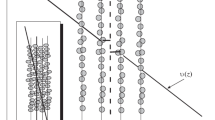Summary
Intrinsic viscosity measurement in highly viscous solvents at high frequency of the shear flow have demonstrated the molecular weight independence of limiting intrinsic viscosity and the constancy of the ratio of internal and solvent viscosity. The former fact proves the adequacy of the formulation of the internal viscosity concept in the normal coordinate space. The latter observation requires the introduction in the molecular model of a new term derived from the excess displacement of chain elements inherent to any deformation of the necklace. As a consequence of conformational limitations by the valency angles and rotational potential energy any deformation of the necklace as described by the displacement of the beads requires displacement of some elements of the real chain in a direction perpendicular to the deformation considered. The resulting frictional forces proportional to the viscosity of the solvent are not included in the frictional coefficient of the beads and hence have to be considered separately as a contribution to internal viscosity.
Zusammenfassung
Messungen desStaudingerschen Viskositätsindex in hochviskosen Lösungsmitteln im hochfrequenten Schergefälle haben die Unabhängigkeit des Grenzindex vom Molekulargewicht und die Konstanz des Verhältnisses zwischen der Innen- und Lösungsmittelviskosität erwiesen. Nach dem ersten Befund erweist sich die Formulierung der Innenviskosität im Normalkoordinatenraum als ausreichend. Das zweite Ergebnis verlangt die Einführung eines neuen Termes in der Innenviskosität, der von der Überschußverschiebung der Kettenelemente herrührt. Als Folge der Konformationseinschränkung durch die Valenzwinkel und Rotationspotentialenergie verlangt eine jede Deformation des Perlschnurmodels, wie sie durch die Perlverschiebung beschrieben wird, die Verschiebung von einigen Gliedern der wirklichen Molekülkette in einer dazu senkrechten Richtung. Die sich daraus ergebenden zusätzlichen Reibungskräfte sind proportional der Lösungsmittelviskosität. Sie sind jedoch nicht in dem Reibungskoeffizienten der Perlen einbegriffen und müssen deshalb gesondert als Beitrag zur Innenviskosität erfaßt werden.
Similar content being viewed by others
References
Kuhn, W. andH. Kuhn, Helv. Chim. Acta29, 609, 830 (1946).
Čopič, M., J. Chim. Phys.54, 348 (1956).
Peterlin, A. andM. Čopič, J. Appl. Phys.27, 434 (1956).
Ikeda, E., Phys. Soc. Japan12, 378 (1957).
Zimm, B. Z., J. Chem. Phys.24, 269 (1956).
Peterlin, A., J. Chem. Phys.33, 1799 (1960).
Fixmann, M., J. Chem. Phys.5, 793 (1966).
Leray, J., Compt. Rend. Acad. Sci. (Paris)241, 1741 (1955); J. Polymer Sci.23, 167 (1957).
Cerf, R., Compt. Rend. Acad. Sci. (Paris)230, 81 (1950); J. Chim. Phys.48, 85 (1951).
Tsvetkov, V. N. andV. P. Budtov, Vysokomol. Soedin6, 1209 (1964).
Cerf, R., J. Phys. & Radium19, 122 (1958).
Cerf, R., Adv. Polymer Sci.1, 382 (1959).
Chaffey, C., J. Chem. Phys.63, 1385 (1966).
Janeschitz-Kriegl, H., Adv. Polymer Sci.6, 170 (1969).
Philippoff, W., Trans. Soc. Rheol.8, 117 (1964).
Ferry, J. D., L. A. Holmes, J. Lamb, andA. J. Matheson, J. Chem. Phys.70, 1685 (1966).
Massa, D. J., J. L. Schrag, andJ. D. Ferry, Macromol.4, 210 (1961).
Osaki, K. andJ. L. Schrag, Polymer J. Japan2, 541 (1971).
Peterlin, A., Kolloid-Z. u. Z. Polymere209, 181 (1966).
Peterlin, A., J. Polymer Sci. A-2,5, 179 (1967).
Peterlin, A. andC. Reinhold, Trans. Soc. Rheol.11:1, 15 (1967).
Author information
Authors and Affiliations
Additional information
With 4 figures and 1 table
Rights and permissions
About this article
Cite this article
Peterlin, A. Molecular model of internal viscosity. Rheol Acta 12, 496–502 (1973). https://doi.org/10.1007/BF01503004
Received:
Issue Date:
DOI: https://doi.org/10.1007/BF01503004




